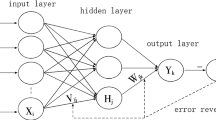Abstract
The technological innovation capabilities of enterprises have a greater impact on regional economic development, and the evaluation of technological innovation capabilities of enterprises has a certain guiding role in the formulation of regional economic development plans. From the current situation, it can be seen that the technological innovation model of enterprises is affected by various factors. Based on deep learning and neural network technology, this research takes a high-tech park as an example to comprehensively evaluate the innovation ability of the high-tech park. The use of predicted values in some evaluation indicators can better reflect the innovation ability. At the same time, this research uses the historical GDP data of the park to predict future values and uses the predicted values as indicators of innovation ability. Finally, the idea of combined forecasting is used to comprehensively evaluate the technological innovation capability of enterprises. The research results show that the method proposed in this paper has certain predictive power, can provide guidance for regional economic development, and can provide theoretical references for subsequent related research.
















Similar content being viewed by others
References
Kandampully J, Bilgihan A, Zhang T (2016) Developing a people-technology hybrids model to unleash innovation and creativity: the new hospitality frontier. J Hosp Tour Manag 29:154–164
Yang C, Hu R, Yang H (2017) Evaluation of technology innovation performance of manufacturing based on PPE-Malmquist–LWM model. Ecol Econ 11:14
Liyong W, Chuanhui H (2016) Influencing factors and model for the regional science and technology innovation resources sharing: a research based on theories of path dependence and innovation diffusion. J Intell 1:32
Briones-Peñalver AJ, Bernal-Conesa JA, de Nieves Nieto C (2019) Knowledge and innovation management model Its influence on technology transfer and performance in Spanish Defence industry. Int Entrep Manag J 1:1–21
Saji BS, Ellingstad P (2016) Social innovation model for business performance and innovation. Int J Prod Perform Manag 65(2):256–274
Gesicho MB, Babic A (2018) Using innovation-decision model to describe the adoption to utilization of HIV-data for decision-making in LMICs. Stud Health Technol Inform 251:117–120
Mejia-Trejo J, Sanchez-Gutierrez J, Gonzalez-Uribe E (2016) Business model, customer needs and innovation management: proposal of a conceptual process for competitive improvement. In: Customer needs and innovation management: proposal of a conceptual process for competitive improvement (August 22, 2016)
Chen H, Wang Y, Song L, Zhang Q (2018) Modeling analysis of complex products resource integration behavior under distributed collaborative technology innovation mode. J Syst Sci Inf 6(3):214–236
Chen H, Wang Y, Song L et al (2018) Modeling analysis of complex products resource integration behavior under distributed collaborative technology innovation mode. Nephron Clin Pract 6(3):214–236
Elia G, Margherita A, Petti C (2016) An operational model to develop technology entrepreneurship “EGO-System”. Int J Innov Technol Manag 13(05):1640008
Tang M, Zhang Y, Zhang Z (2016) The rise of China environmental protection industry and its development countermeasures: an empirical research in Suzhou City. In: 2016 IEEE international conference on management of innovation and technology (ICMIT). IEEE, pp 121–126
Gallos P, Minou J, Routsis F, et al (2017) Investigating the perceived innovation of the big data technology in healthcare. In: ICIMTH, pp 151–153
Howard SK, Thompson K, Yang J, Ma J (2019) Working the system: development of a system model of technology integration to inform learning task design. Br J Educ Technol 50(1):326–341
Holland DD, Piper RT (2016) High-trust leadership and blended learning in the age of disruptive innovation: strategic thinking for colleges and schools of education. J Leadersh Educ 15(2):1–8
Dapeng Y, Songting P, Ning C (2016) Enterprise innovation and entrepreneurial strategy development in perspective of positive organizational behavior. J Comput Theor Nanosci 13(12):9353–9357
Wang Y, Shen WX (2016) Study on innovation model of agricultural transgenic biological technology. J Biol 33(02):86–90
Jiang WP, Ji RW, Huang WL (2016) Construction of dynamic model on influencing mechanism of technology innovation alliance to enterprise’s technological performance based on the network embeddedness perspective. Chin J New Drugs 25(20):2294–2300
Weibai L, Zhong L (2016) On the option game model of the investment decisions for radical technology innovation in enterprises. Manag Rev 28(04):89–97
Kim SA, Ryoo HY, Ahn HJ (2017) Student customized creative education model based on open innovation. J Open Innov Technol Mark Complex 3(1):6
Angelidis P, Berman L, Casas-Perez MD, Celi LA, Dafoulas GE, Dagan A, Escobar B, Lopez DM, Noguez J, Osorio-Valencia JS, Otine C (2016) The hackathon model to spur innovation around global mHealth. J Med Eng Technol 40(7–8):392–399
Lu W-L, Wei S-Y (2018) Process, model and factors of governance innovation in local governments with the development of internet technology—illustrated by the governance of online car-hailing service. J Northeastern Univ (Soc Sci) 20(01):66–72
Jie D, Xianjun H (2016) Knowledge spillover effect on technology innovation in Guangdong Province based on spatial measurement. J Shenzhen Univ (Sci Eng) 33(04):367–376
Fan IYH, Lee RWB (2016) Intellectual capital-based innovation planning: empirical studies using wiNK model. J Intellect Cap 17(3):553–569
Leydesdorff L, Ivanova I (2016) “Open innovation” and “triple helix” models of innovation: can synergy in innovation systems be measured? J Open Innov: Technol Mark Complex 2(1):1–12
Author information
Authors and Affiliations
Corresponding author
Ethics declarations
Conflict of interest
The authors have no competing interests.
Additional information
Publisher's Note
Springer Nature remains neutral with regard to jurisdictional claims in published maps and institutional affiliations.
Rights and permissions
About this article
Cite this article
Zhen, Z., Yao, Y. Optimizing deep learning and neural network to explore enterprise technology innovation model. Neural Comput & Applic 33, 755–771 (2021). https://doi.org/10.1007/s00521-020-05106-z
Received:
Accepted:
Published:
Issue Date:
DOI: https://doi.org/10.1007/s00521-020-05106-z




